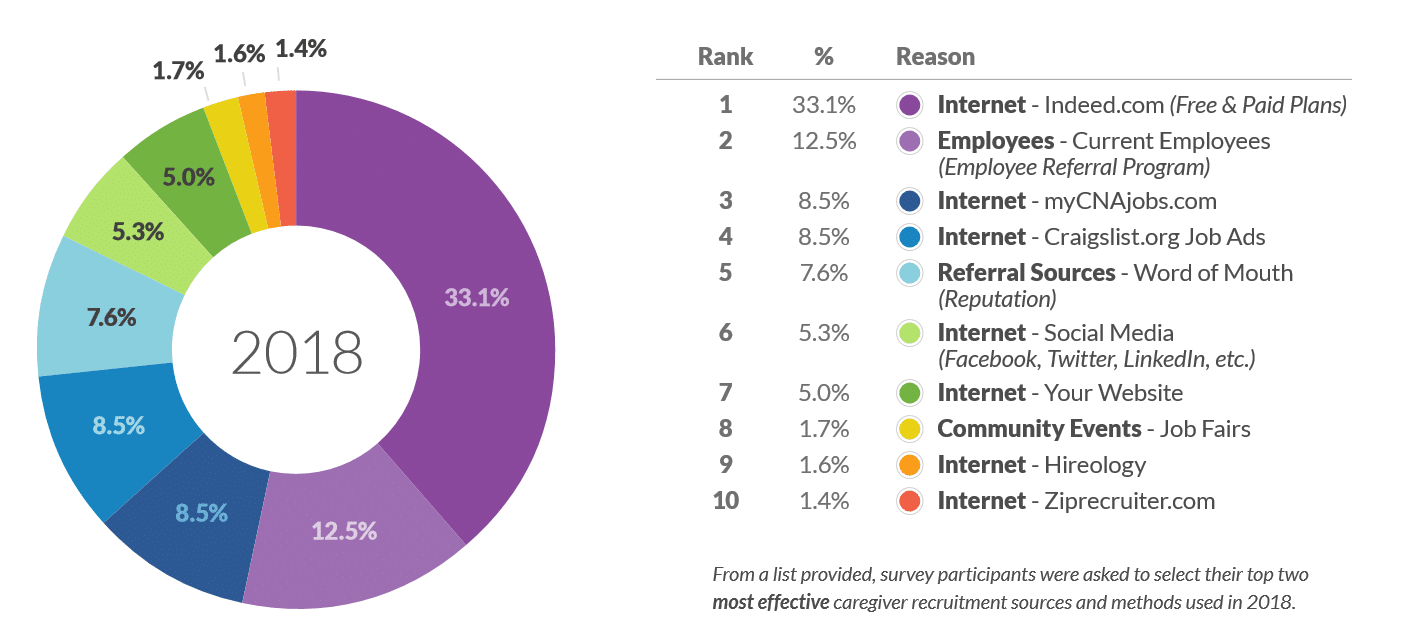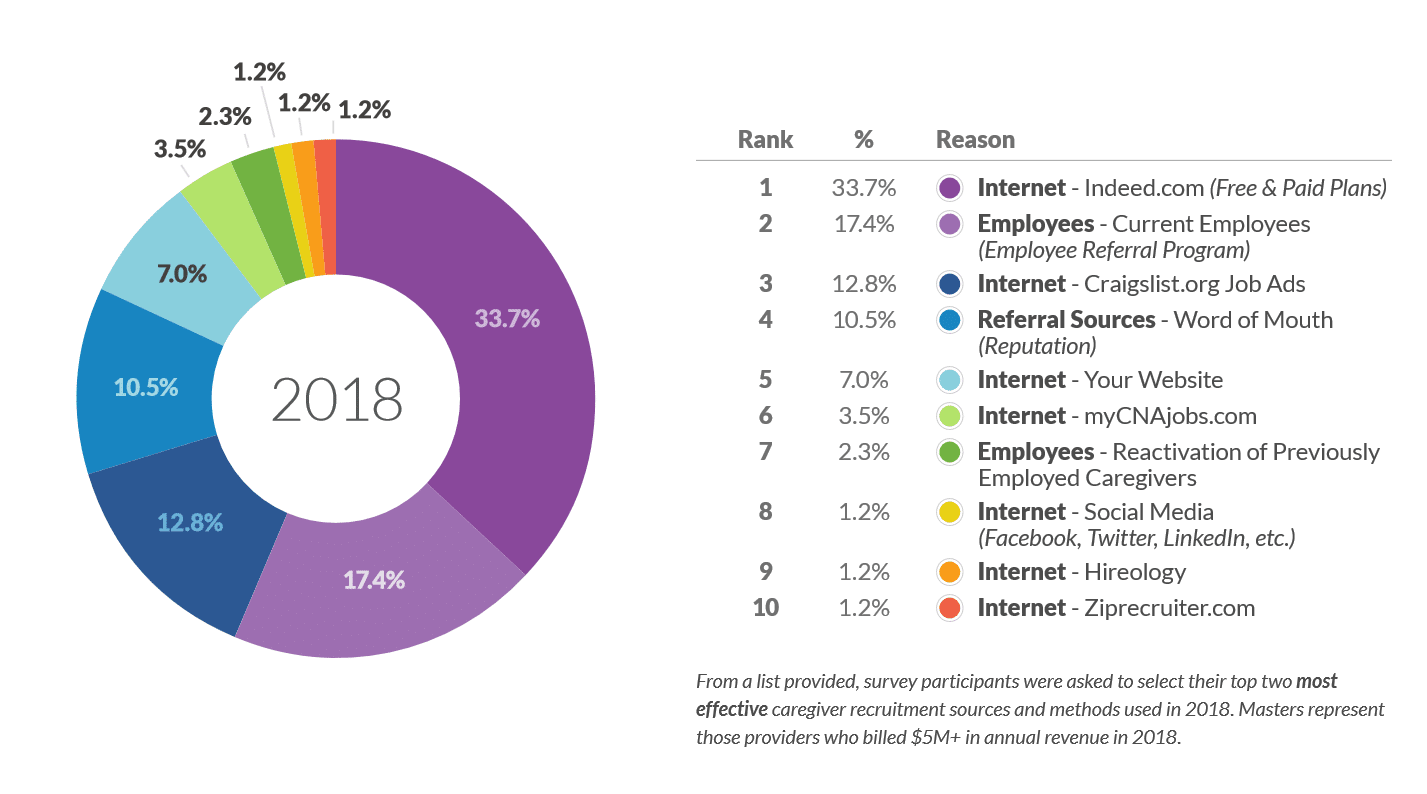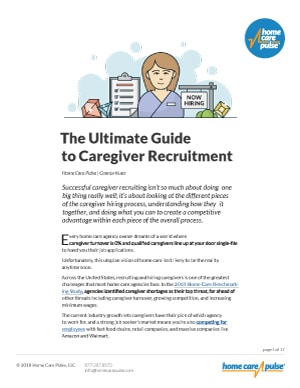Successful caregiver recruiting isn’t so much about doing one big thing really well; it’s about looking at the different pieces of the caregiver hiring process, understanding how they fit together, and doing what you can to create a competitive advantage within each piece of the overall process.
Every home care agency owner dreams of a world where caregiver turnover is 0% and qualified caregivers line up at your door single-file to hand you their job applications.
Unfortunately, this utopian vision of home care isn’t likely to be the reality anytime soon.
Across the United States, recruiting and hiring caregivers is one of the greatest challenges that most home care agencies face. In the Home Care Benchmarking Study, agencies consistently identify caregiver shortages as their top threat, far ahead of other threats including rising competition and increasing minimum wages.
The current industry growth lets caregivers have their pick of which agency to work for, and a strong job seeker’s market means you’re also competing for employees with fast food chains, retail companies, and massive companies like Amazon and Walmart.
The problem isn’t going away anytime soon. The US Census Bureau estimates that by 2030, seniors will outnumber children for the first time in US history—foreshadowing a massive future need for more caregivers.
Fortunately, there’s a lot you can do. Successful caregiver recruiting isn’t so much about doing one big thing really well; it’s about looking at the different pieces of the caregiver hiring process, understanding how they fit together, and doing what you can to create a competitive advantage within each piece of the overall process.
Data from 2,000+ home care agencies and over a decade of experience helping home care agencies overcome roadblocks like these have given us a lot insight into hiring caregivers. Here’s what you can do to hire more caregivers, hire better caregivers, and hire caregivers who will stick around.

SECTION 1
3 Important Questions to Ask Before You Start Hiring Caregivers
Do you view caregivers as assets or commodities?
Before we dive into the various caregiver recruiting sources out there, we need to address the first place where agencies go wrong in hiring caregivers.
During a recent interview we conducted for an agency to gauge their caregivers’ level of satisfaction, a frustrated caregiver told our team: “[My agency] doesn’t care who they hire. They just need a warm body to fill the slot.”
Because most caregiving jobs require little by way of technical qualifications or past experience, and because of the sheer volume and high turnover of caregivers employed by most agencies, many agency owners come to view caregivers as transient commodities that can be quickly replaced rather than high-value assets that need to be carefully curated and developed.
Don’t fall into this way of thinking!
Seeing caregivers as commodities is a short-term mindset that causes agencies to care more about hiring a warm body to fill a shift than finding someone great who will love what they do and do a great job.
If you put in the extra effort to identify the best caregivers and treat them as the core assets of your business, you’ll find that a lot of good things happen:
The most successful home care agencies are those that view their caregivers as indispensable assets and treat them accordingly.
FREE RESOURCE
Focus your recruiting on the right candidates with the Targeted Recruitment Strategy Tool
Is Your Hiring Criteria Screening Out Great Applicants?
According to Brandi Kurtyka, CEO of myCNAjobs, many agencies have arbitrary hiring criteria that rules out a lot of great caregivers before they even apply. For example, many agencies mandate in their job postings that applicants have CPR certifications before they apply.
Would you turn down a great applicant who is reliable, compassionate, and good with people because they lack a certification that you could provide with an evening of training? Many job postings do just that by listing unnecessary qualifications, causing potential caregivers to pass over your agency before you even have the option to choose whether to hire them or not.
Would you turn down a great applicant who is reliable, compassionate, and good with people because they lack a certification that you could provide with an evening of training?
It’s good to have high standards, but there’s a difference between high standards for qualities (compassion, dependability, integrity, a strong work ethic) that cannot easily be taught, and specific training or certifications that can be gained on the job.
Take some to consider what is truly necessary to require in your job listing. Don’t settle for inferior caregivers, but recognize that by focusing on the personality traits you want and supplementing it with a strong training system you can expand your hiring pool and claim a strong competitive advantage in hiring.
How Well Do Your Job Postings Grab the Right Applicants’ Attention?
Writing the right job postings is a critical part of attracting these caregivers. Job postings are typically your first contact with the caregivers, and used properly they can filter out unwanted caregivers while acting as a beacon to the kind of caregivers you want.
Asking the following questions can help you understand if a job posting is effective:
If you answered no to one or more of those questions, try some of the following tips:
List the need-to-know information right at the top. At a glance, potential caregivers should know the basic details: pay, hours/shifts, how soon you need them to start, and any other important benefits.
Take a relatable tone that addresses the caregivers directly. This makes it easier to read and helps them feel a stronger connection to your agency.
Give some specifics to help make it more real (without giving away confidential information). “We are looking for a compassionate caregiver who will be provide companionship and basic daily care to a 72-year-old veteran who loves jazz and recently lost his wife” is much more compelling than “Caregiver needed to take care of elderly clients.”
Openly address what you aren’t looking for in addition to what you are looking for. You may include a statement like:
“Here at [name of your agency], our mission is to improve lives through dedicated care. Please do not apply if your main purpose is to find any job that will get you by in the short term. But if you are passionate about providing care and are willing to challenge yourself daily to make a positive impact on the lives of those you care for, we want YOU on our team.”
Display awards that you’ve won. If you’re a Best of Home Care – Employer of Choice, show it!
Include caregiver testimonials about what it’s like to work there (video, if possible). Try having a few caregivers make brief selfie videos discussing what they like about your agency. What your caregivers say about your agency matters much more than anything you can say about your agency
QUESTION TO CONSIDER: Sales guru Brian Tracy famously defined sales as “the transfer of enthusiasm.” How will you use your job postings to transfer enthusiasm about your agency to your prospective caregivers?

SECTION 2
Choosing Caregiver Recruitment Sources that Save You Money and Increase Retention
A Scientific Approach to Choosing Recruitment Channels
After you’ve defined what you want in caregivers, you’ll need to decide which recruiting channels to use. While it’s usually a good practice to throw your recruiting net out wide to encompass a variety of channels, you should also concentrate your best efforts on the channels most likely to deliver the best caregivers at the lowest cost.
There are two metrics that are very important to keep in mind:
- Caregiver acquisition cost—the total cost to hire a caregiver from a given recruiting source.
- Caregiver turnover rate—The percentage of caregivers recruited through a given source who leave within a year.
The lower the turnover rate, the longer you can expect your caregivers to stay, which saves you money and results in better client care long-term. Typically, many of the sources that produce caregivers with a lower turnover rate have a higher acquisition cost. Since the average cost of replacing a caregiver is estimated at $2,700, this higher acquisition cost often pays for itself if it means those caregivers will stay longer.
Still, you should carefully evaluate the costs of each channel and decide which ones will be best to use based on your budget and the effectiveness of these channels in your specific area.
While the ideal strategy would be to pursue the channels with the lowest caregiver turnover, this is not always realistic if those channels simply aren’t turning up enough caregivers or are too expensive to rely on. Let’s take a look at the top recruitment sources agencies reported last year:

And for added perspective, here’s how the industry leaders (agencies billing more than $5M in annual revenue) are recruiting:

Let’s talk a little about each channel. We’ll start with employee referral programs.
Employee Referral Programs
An employee referral program is pretty simple—you pay an employee when you hire an applicant that they referred to you. The trick with employee referral programs is to create a very simple process that works the same every time and make sure that everyone within your company knows about the program. We recommend the following plan:
1. Offer a given incentive for referring an applicant who is hired. The amount most often offered by agencies using this strategy is $100, as of 2017; however, we recommend that you may want to offer as much as $200, just to ensure heavy participation. Caregivers referred by other caregivers typically become some of the best members of your team and are worth the extra investment.
2. Decide exactly when it will be paid and follow through with it. This is a balancing act between the instant gratification that will motivate future participation while providing inventive to refer employees who will stick around. You may decide to give half the reward immediately upon hiring the referral, and the other half once they reach a milestone of 60 or 90 days with your company. Whatever you do, make sure you clearly advertise it and that you do the same for everyone.
3. Create a simple, consistent process to log referrals. Everyone in your company should know where and how to submit referrals. No referrals should slip through the cracks, and you should contact referrals as soon as possible—ideally the same day.
4. Make sure everyone in your company is aware of the program and understands it. Avoid confusion by creating a simple system and sticking to it, and then remind people about it. Bring it up at training meetings, tell new employees at orientation, post it in your office, and have your staffing coordinators or caregiver mentors remind caregivers about it. If you’re especially short on applicants, you may send out a text to all your caregivers reminding them about it the program. Keep it at the forefront of their minds.
Internet Lead Sites
If you’re not using internet lead sites to recruit caregivers, you’re missing out on a potentially massive recruitment source. There are a multitude of websites out there that help caregivers find you, but we’ll talk about some of the most important ones.
The three most-used lead sites in home care are myCNAjobs.com, Indeed.com. and craiglist.org. Over 50% of the caregivers hired in 2017 were recruited through one of these three sources, according to the 2018 Home Care Benchmarking Study.
Other popular internet lead sites include:
Besides lead sites, consider these other internet-based options:
Take care to balance your use of job-seeking websites with other sources. While they often have a low acquisition cost and can deliver a high volume of employees, it’s also harder to guarantee the quality of an employee you found through the Internet.
Recruiting Through Word of Mouth
Recruiting caregivers through word of mouth isn’t about hoping your caregivers are talking you up and waiting passively for referrals to come in; it’s about working to provide a great experience to your caregivers and then actively facilitating opportunities for your agency to become the topic of conversation.
There are plenty of small ways that you can help facilitate conversations (both in person and online) about your agency. This include (but are definitely not limited to):
 NOTE: When it comes to listening to your caregivers, Home Care Pulse customers have an advantage, as our services provide detailed feedback from your caregivers on where you can improve—often with a level of honesty and directness that wouldn’t come without a third party conducting the interviews. We also provide tools that allow you to track how many of your caregivers are promoters of your business and see how to increase this number.
NOTE: When it comes to listening to your caregivers, Home Care Pulse customers have an advantage, as our services provide detailed feedback from your caregivers on where you can improve—often with a level of honesty and directness that wouldn’t come without a third party conducting the interviews. We also provide tools that allow you to track how many of your caregivers are promoters of your business and see how to increase this number.
Home Care Pulse customers also have the advantage of being eligible to receive Best of Home Care Awards like Employer of Choice, based on satisfaction scores from their caregivers. You can learn more about getting feedback from your caregivers (and clients) here and more about qualifying for awards here.
Job Fairs and Other Caregiver Recruiting Events
Many communities and colleges host job fairs to connect employers with potential employees, and these can be excellent recruiting channels. If you’re interested in using a local job fair to find caregivers, remember these two tips:
1. Have caregivers manning your booth in addition to you or your office staff. Your caregivers are your most powerful recruiting tool. Enlist personable, excited caregivers at your booth to engage potential applicants and demonstrate to them the value of working for your company.
2. Go above and beyond to make your booth stand out to potential applicants. Like with job postings, your booth only has a few seconds to grab the attention of applicants, so do something to make it novel! At the very least, keep engaging people at the booth, make sure your booth looks clean and professional, and keep physical items at the booth that can be given away. This may include literature about your agency, free branded items like pens or lanyards, and candy. This entices people to come to your booth and provides free advertising to you when they take the item.
However, one of the most powerful recruiting events, done properly, can be an open house hosted by your own company. Why rely on other fairs when you can hold your own?
An open house is just like it sounds: a time for prospective employees to come mingle with your staff and interview to work at your agency. Done properly, it can accomplish in one night what might otherwise take weeks to get done. It also provides a double screening process: providing time for applicants to casually mingle with your staff might show a side of them you wouldn’t see in the interview.
Done properly, an open house can accomplish in one night what might otherwise take weeks to get done.
FREE RESOURCE
Focus your recruiting on the right candidates with the Targeted Recruitment Strategy Tool
LOOKING FOR MORE RECRUITING CHANNELS? Check out this list: 101 Ways to Recruit More Caregivers.

SECTION 3
Running Caregiver Interviews that Make the Best Applicants Shine
Nearly every home care owner has the frustrating experience of hiring a caregiver who seemed great in the interview but proves to be a poor employee.
This is no surprise. Most caregiver interviews last no more than about 15 minutes, which is a very small amount of time to get a good grasp on the kind of employee someone will be.
So, how do you use this short amount of time to prove whether someone will make a great caregiver or not?
Here are seven tips we’ve pulled together from talking to experts across the industry. Some of them help you pick out the best applicants, and some of them simply help to make your interview process efficient as possible so that you can keep applicants in your caregiver hiring pool until you’re ready to make your decision.
You’re probably already doing some of these, but it’s key to remember that this process is most successful when you use all of these in conjunction with each other. Many of these will sound obvious and even simplistic—yet very few home care agencies are actually doing all these effectively.
Tip #1: Look for candidates who identify with your why.
Caregivers who identify with the mission and principles of your agency will generally give better care to your clients and remain with your agency longer. If you’re making it a goal to identify these caregivers throughout the hiring process—for instance, by describing what you are looking for explicitly in your job postings—then you will already be well underway toward accomplishing this. To further accomplish this in the interview, you might try the following:
Tip #2: Use an interview format that allows for multiple interviews with multiple team members.
While it’s important to keep your process simple and speedy—a sluggish hiring process sacrifices too many applicants to other companies—taking time to conduct multiple interviews gives you a more in-depth look at your applicants. Here are two formats you might consider using:
Standard Interviews:
- Screener phone interview with caregiver supervisor
- In-person interview with another office member as soon as possible
- Same-day in-person interview with you or other top management
Open house:
- Pitch about your agency to group of applicants
- Time for applicants to mingle with your caregivers and staff
- In-person interview with you or other top management
Tip #3: Ask tough interview questions focused on hypothetical scenarios and specific past experiences.
There’s no silver bullet question, but if you ask questions that require them to dig in deep it’s difficult to embellish or fabricate a response. Plan questions ahead of time so that you can ensure that you cover everything you need to.
Besides basic questions about themselves and their background, you might ask other questions such as:
You can also gain insight by asking questions addressing their needs as an employee:
And finally, throw in a few fun questions that bring out their personality while still requiring some thinking:
For a much larger bank of questions you can ask, check out our article 65 Caregiver Interview Questions to Help You Hire the Right Caregivers.
Tip #4: Develop a consistent screening process.
While your specific process may depend on your location, resources, and the needs of your agency, you should develop a strong, consistent screening process that you use every time. While these are likely not all necessary, your process may include steps such as:
Tip #5: Be transparent about the difficulties of the job and the kind of hours/pay they can expect.
One very common complaint from caregivers in 2018 is that they feel that they were misled about the kind of schedule they would be getting.
Never sugarcoat aspects of the job, especially regarding the kind of hours, assignments, or pay they should expect; this is a short-term strategy that will create more problems and stress in the long run.
Doing this has one major benefit to you: it will weed out caregivers who aren’t compatible with the job. While you’re not trying to scare caregivers off, you want to hire caregivers who go into the job fully understanding both the positive and negative aspects—and are excited about it.
Tip #6: Keep strong communication so that applicants are always in the loop.
Text them on the morning of the interview to confirm that they’re still able/planning to come. This will save you time waiting for no-shows. When your staff sets up an interview, ensure that they tell the interviewee who they’ll be interviewing with, what to expect, and anything else that would be useful for them to know. When they leave an interview, set clear expectations for what to expect next and when to expect it.
Tip #7: Hold yourself and your staff to the same standard of punctuality and professionalism that you hold applicants to.
Stories of applicants who show up to find an employer unprepared or out of the office are all too common. While sometimes crises happen that require your attention, do everything in your power to be on time starting the interview and be organized in all your communication and interactions with the applicant. The best applicants—those are punctual and reliable themselves—will respond very positively to this.

SECTION 4
Retaining New Caregivers From the Interview Through Their First 90 Days
You’ve hired a great caregiver, but now what? You might be familiar with some of the statistics—67% of caregivers will leave their agency this year, and 57% of those caregivers who leave will do so in their first 90 days, according to the Home Care Benchmarking Study. Some caregivers are hired but fail to show up to their first day.
Why Caregivers Sometimes Don’t Show Up for Their First Day
There are typically two main reasons why caregivers don’t show up to their first day:
- They took a job someplace else. This is especially likely if your hiring process is slow, or if you have a long break between hiring them and scheduling them to start work. According to myCNAjobs, many caregivers continue to interview with other companies after they receive an offer; also, many caregivers are willing to start work within three days.
Solution: Speed up the turnaround time for your hiring and onboarding process so that timeliness becomes a competitive advantage for your agency.
- They’ve decided the job isn’t for them and they’re “ghosting” you. It may be that there was a miscommunication in the interview process, and they no longer want the job but don’t want to say so. In today’s day and age, kids call it “ghosting” and it’s usually applied to dating—rather than breaking up with someone, they may choose to simply stop talking to them and ignore the person on their phone. Unfortunately, many applicants carry this way of doing things over to employment.
How can you avoid being left high and dry if a flaky new hire decides to “ghost” you? Give them a phone call between hiring them and their first scheduled shift. Ask if they have any questions and confirm that they’re still good to come in. If they act hesitant, ask follow-up questions.
This will help ensure that everyone is on the same page—if they’re ready and eager to start working, this will simply help them feel valued and in the loop. If they feel like the job isn’t for them and feel awkward about saying so, this will give them the opportunity to come clean before it causes bigger problems.
Supporting Caregivers During Their First 90 Days
As your caregivers get into the swing of the job, it’s critical to help them feel supported, provide good training, and keep consistent communication. Because caregivers rarely get to see their coworkers, they often feel disconnected from their agency and become dissatisfied with their work. Your job is to help them feel like a part of a team and empower them to succeed.
Here’s what you can do to retain caregivers for their first 90 days:
1. Start them off with a solid orientation that gives them all the basic knowledge they need. Make sure they understand how to read care plans, how to stay safe on the job and keep their clients safe, what to expect as far as hours and pay, and who to talk to if they have questions or need help.
2. Maintain frequent communication. There’s a simple rule of thumb—if you only communicate with your caregivers when you need something from them, you’re doing it wrong. Text them to check in how they’re doing, call to ask about their clients, and always ask what you can do to help them succeed in their work.
3. Give them a caregiver mentor. A mentor is simply an experienced caregiver who is assigned to look after less experienced caregivers. They should accompany a caregiver on some of their first visits with clients and check in with them frequently for their first 90 days. Eventually, the new hire can climb the ladder and become a mentor to new caregivers themselves.
4. Provide plenty of training. Hold regular training meetings to ensure that your caregivers have the skills, certification, and confidence they need. Additionally, make sure they know who to go to if they have additional questions or have clients with unusual needs.
5. Show them recognition for their work. In the thousands of caregiver surveys we conduct every month, one of the areas they consistently rate their agencies the lowest is in the level of recognition they receive. Caregivers want to feel recognized for their hard work. Consider ways that you can validate your caregivers when they go above and beyond.
If you excel at each of these steps and are still struggling with extreme turnover from new hires, it may be a sign that you have a blind spot and need feedback from your caregivers to identify the problem. To learn how you can get direct, unbiased feedback from your caregivers, learn more about our survey program or request a call from one of our home care specialists.
There’s a Lot More Where This Came From
If the Ultimate Guide to Caregiver Recruitment was useful to you, here’s what you should do:
- Subscribe to our email list below to get weekly content delivered right to your inbox.
- Keep an eye out for Ultimate Guides to other topics including caregiver retention, marketing, staffing, and client satisfaction. They’ll be coming out in the near future and if you’re on our email list, we’ll let you know when they’re done.
- Leave us a comment below to let us know what was useful and what we should have covered that we didn’t.
- LIVE WEBINAR
5/15: How to Become a Magnet for Top Candidates as a ‘Great Place to Work’











I am a care giver i want to learn and hear more from you
I am a home care provider and I would like to hear from you